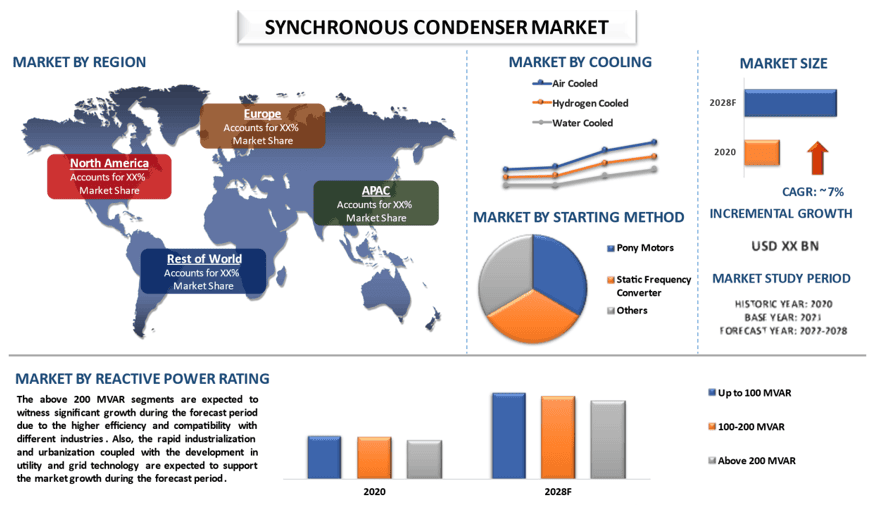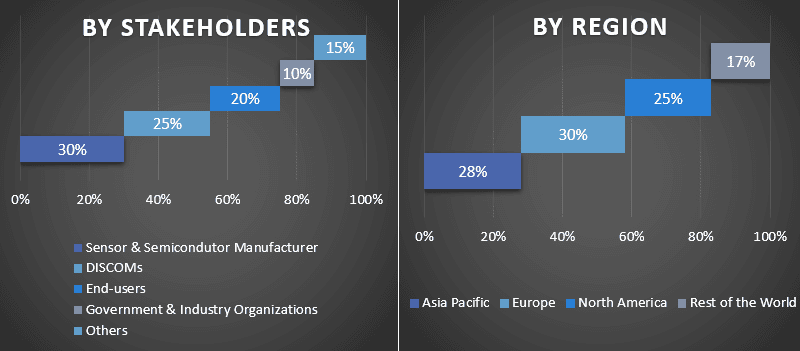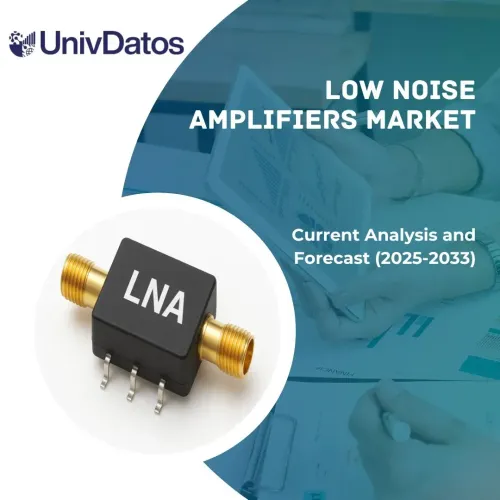同期調相機市場:現状分析と予測(2022年~2028年)
冷却方式(空冷、水素冷却、水冷)の重視;始動方式(ポニーモータ、静止形周波数変換装置、その他);無効電力定格(100 MVAR、100~200 MVAR、200 MVAR以上);および地域/国

世界の同期調相機市場は、予測期間中に約7%の高い成長率で成長すると予想されています。 同期調相機は、同期補償器または同期コンデンサとも呼ばれ、シャフトが駆動装置に接続されていないDC励磁同期機または大型回転発電機です。同期補償器または同期コンデンサとも呼ばれます。同期調相機は、同期慣性を供給することにより、洗練された短絡強度と周波数で調整可能な無効電力を継続的に吸収/生成することにより、電圧調整と安定性を向上させるために利用されます。同期調相機は、システムの力率を調整できるため、近年需要が大幅に増加しています。同期調相機は、送配電電圧レベルの両方で、変化する緊急事態のシナリオや負荷条件の下で、必要な制限を維持するためにも利用できます。
General Electric、ABB、WEG、Eaton Corporation、Mitsubishi Electric Corporation、Siemens Energy、Power System and Control、Bharat Heavy Electricals Limited、Shanghai Electric、Fuji Electricは、市場の主要なプレーヤーの一部です。これらのプレーヤーは、ハイテクで革新的な製品/技術で顧客を支援するために、いくつかのM&Aとパートナーシップを実施しています。
レポートで提示されたインサイト
「冷却タイプの中で、水素冷却カテゴリーが予測期間中に高いCAGRを示す」
冷却タイプに基づいて、市場は空冷、水素冷却、水冷に分類されます。比熱が高く、密度が低く、熱伝導率が高いなど、さまざまな特性があるため、水素冷却セグメントは、予測期間を通じてかなりのCAGRを経験すると予想されます。水素冷却される同期調相機は、より高いエネルギー効率、向上した耐久性、および低減されたノイズを提供します。さらに、水素によって冷却された同期調相機は、空冷の対応製品よりも1.5倍多くの熱伝達を提供し、密度は1/14です。
「始動方法の中で、静止形周波数変換器が2020年に市場で大きなシェアを握る」
始動方法に基づいて、市場はポニーモータ、静止形周波数変換器、その他に分類されます。設置費用が安く、独立した供給電圧、負荷変動があるため、静止形周波数変換器カテゴリーは、予測期間を通じてかなりの市場拡大が見込まれます。さらに、静止形周波数変換器は、近い将来の市場の成長を支援し、より高い信頼性、不平衡負荷での強化された性能、および高周波安定性を提供します。さらに、静止形周波数変換器は、電力の送電、発電、配電で広く使用されており、性能を最適化します。
「アジア太平洋地域が市場で大きなシェアを握る」
2020年、アジア太平洋地域は、世界の同期調相機市場で大きなシェアを握っていました。これは主に、拡大する業界と、増加する送配電インフラ投資に起因します。さらに、近い将来、市場には旧式の電力インフラが普及し、電力線電圧調整を改善するために、より最新のインフラに置き換えられます。また、回路電流の直線的な流れのためのデータセンター業界でのクローズドループ電流センサーの採用の増加と、連続供給のためのスイッチモード電源の採用は、この地域の市場の成長を促進すると予想されます。さらに、投資と研究開発活動の増加、および新しいパートナーシップとM&Aは、今後の市場の成長をサポートすると予想されます。たとえば、2020年4月、シリコンラボラトリーズは、低電力接続ポートフォリオを多様化し、現在のセンサー電力製品市場を強化するために、Redpine信号を買収しました。
このレポートを購入する理由:
- この調査には、認証された主要な業界専門家によって検証された、市場規模の測定と予測分析が含まれています。
- レポートは、業界全体のパフォーマンスの簡単なレビューを一目で示しています。
- レポートは、主要なビジネス財務、製品ポートフォリオ、拡張戦略、および最近の開発に焦点を当てた、著名な業界ピアの綿密な分析を網羅しています。
- 業界で普及している推進要因、制約、主要なトレンド、および機会の詳細な調査。
- この調査では、さまざまなセグメントにわたる市場を包括的に網羅しています。
- 業界の地域レベルの詳細な分析。
カスタマイズオプション:
世界の同期調相機市場は、要件またはその他の市場セグメントに応じて、さらにカスタマイズできます。これに加えて、UMIは、お客様独自のビジネスニーズがある可能性があることを理解しているため、お客様の要件に完全に適合するレポートを入手するためにお気軽にお問い合わせください。
目次
同期コンデンサ市場分析(2022年~2028年)の調査方法
世界の同期コンデンサ市場の過去の市場を分析し、現在の市場を推定し、将来の市場を予測することは、世界の主要地域における同期コンデンサの採用を構築および分析するために行われた3つの主要なステップでした。過去の市場数を収集し、現在の市場規模を推定するために、徹底的な二次調査が実施されました。次に、これらの洞察を検証するために、多数の調査結果と仮定が考慮されました。さらに、グローバル同期コンデンサ市場のバリューチェーン全体にわたる業界の専門家との徹底的な主要インタビューも実施されました。主要なインタビューを通じて市場の数値を仮定および検証した後、完全な市場規模を予測するためにトップダウン/ボトムアップアプローチを採用しました。その後、市場の内訳とデータの三角測量法を採用して、業界に特有のセグメントとサブセグメントの市場規模を推定および分析しました。詳細な方法論について以下に説明します。
過去の市場規模の分析
ステップ1:二次ソースの詳細な調査:
年次報告書と財務諸表、業績プレゼンテーション、プレスリリースなどの企業内部ソース、およびジャーナル、ニュースと記事、政府刊行物、競合他社の刊行物、セクターレポート、サードパーティデータベース、その他の信頼できる刊行物などの外部ソースを通じて、同期コンデンサ市場の過去の市場規模を取得するために、詳細な二次調査を実施しました。
ステップ2:市場セグメンテーション:
同期コンデンサ市場の過去の市場規模を取得した後、主要地域のさまざまなセグメントとサブセグメントに関する過去の市場の洞察とシェアを収集するために、詳細な二次分析を実施しました。主要なセグメントは、冷却タイプ、始動方法、無効電力定格としてレポートに含まれています。さらに、地域におけるテストモデルの全体的な採用を評価するために、国レベルの分析が実施されました。
ステップ3:要因分析:
さまざまなセグメントとサブセグメントの過去の市場規模を取得した後、同期コンデンサ市場の現在の市場規模を推定するために、詳細な要因分析を実施しました。さらに、同期コンデンサの冷却タイプ、始動方法、無効電力定格などの従属変数と独立変数を使用して、要因分析を実施しました。世界の同期コンデンサ市場セクターにおけるトップパートナーシップ、合併と買収、事業拡大、製品発売を考慮して、需要と供給側のシナリオについて徹底的な分析を実施しました。
現在の市場規模の推定と予測
現在の市場規模の算出:上記の3つのステップからの実用的な洞察に基づいて、現在の市場規模、世界の同期コンデンサ市場の主要なプレーヤー、およびセグメントの市場シェアに到達しました。必要なすべてのパーセンテージシェアの分割と市場の内訳は、上記の二次的なアプローチを使用して決定され、主要なインタビューを通じて検証されました。
推定と予測:市場の推定と予測のために、利害関係者が利用できる推進要因とトレンド、制約、機会を含むさまざまな要因に重みが割り当てられました。これらの要因を分析した後、関連する予測手法、つまりトップダウン/ボトムアップアプローチを適用して、グローバル市場全体のさまざまなセグメントとサブセグメントの2028年の市場予測に到達しました。市場規模の推定に採用された調査方法論には、以下が含まれます。
- 収益(USD)の観点からの業界の市場規模と、国内の主要市場全体での同期コンデンサ市場の採用率
- 市場セグメントとサブセグメントのすべてのパーセンテージシェア、分割、および内訳
- 提供される製品の観点から見た、グローバル同期コンデンサ市場の主要なプレーヤー。また、急速に成長する市場で競争するために、これらのプレーヤーが採用した成長戦略
市場規模とシェアの検証
一次調査:主要な地域全体で、トップレベルの幹部(CXO / VP、営業部長、マーケティング部長、運用部長、地域部長、カントリー部長など)を含む主要なオピニオンリーダー(KOL)との詳細なインタビューを実施しました。次に、一次調査の結果を要約し、述べられた仮説を証明するために統計分析を実行しました。一次調査からのインプットは二次調査の結果と統合され、情報が実用的な洞察に変わりました。
さまざまな地域における一次参加者の分割

市場エンジニアリング
データ三角測量法を採用して、グローバル同期コンデンサ市場全体の市場推定を完了し、各セグメントおよびサブセグメントの正確な統計数に到達しました。グローバル同期コンデンサ市場における冷却タイプ、始動方法、無効電力定格の分野におけるさまざまなパラメーターとトレンドを調査した後、データをいくつかのセグメントとサブセグメントに分割しました。
グローバル同期コンデンサ市場調査の主な目的
グローバル同期コンデンサ市場の現在および将来の市場動向は、調査で特定されました。投資家は、調査で実施された定性的および定量的分析に基づいて、投資の裁量に基づいた戦略的洞察を得ることができます。現在および将来の市場動向は、地域レベルでの市場の全体的な魅力を決定し、産業参加者が未開発の市場を利用して先行者利益を得るためのプラットフォームを提供しました。調査のその他の定量的な目標は次のとおりです。
- 価値(USD)の観点から、同期コンデンサ市場の現在および予測市場規模を分析します。また、さまざまなセグメントおよびサブセグメントの現在および予測市場規模を分析します
- 調査のセグメントには、冷却タイプ、始動方法、無効電力定格の分野が含まれます。
- 同期コンデンサの規制の枠組みを定義して分析する
- さまざまな仲介業者の存在を伴うバリューチェーンを分析し、業界の顧客と競合他社の行動を分析します。
- 主要地域における同期コンデンサ市場の現在および予測市場規模を分析します。
- レポートで調査された地域の主要国には、アジア太平洋、ヨーロッパ、北米、および世界のその他の地域が含まれます。
- 同期コンデンサ市場の企業プロファイルと、急速に成長する市場で持続するために市場プレーヤーが採用した成長戦略
- 業界の詳細な地域レベルの分析
関連 レポート
この商品を購入したお客様はこれも購入しました









